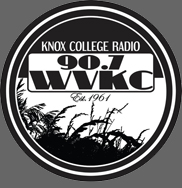 As we wrote back in August, changes were planned for Knox College radio station WVKC, following a deal with Tri States Public Radio. The student radio station in Illinois was slated to move off its 90.7 FM signal in exchange for a beefed up Internet feed and an HD channel. With the new school year in full-swing, WVKC is now heard on its new digital home and public radio programming from Tri States Public Radio is airing on 90.7 FM under a 20-year management agreement. The station itself is being spruced up and its record library will soon be accessible to all students. An article in the Knox Student states,
As we wrote back in August, changes were planned for Knox College radio station WVKC, following a deal with Tri States Public Radio. The student radio station in Illinois was slated to move off its 90.7 FM signal in exchange for a beefed up Internet feed and an HD channel. With the new school year in full-swing, WVKC is now heard on its new digital home and public radio programming from Tri States Public Radio is airing on 90.7 FM under a 20-year management agreement. The station itself is being spruced up and its record library will soon be accessible to all students. An article in the Knox Student states,
“Since the switchover to digital streaming, little else has changed for the WVKC staff apart from a new stream encoder that has been installed in the broadcast studio and has not impacted the day-to-day operations of the station.”
Former station staffer Andrea Miklasz penned a letter to the editor of the Knox Student, expressing sadness over these changes. She writes,
“I do not believe that giving up a 1000 watt radio broadcast signal in exchange for Internet streaming abilities and HD radio broadcast capability is a good deal for WVKC, Knox College or the Galesburg community. I believe that the Knox administration saw a way to save money and took advantage of what may have been the naivete of the student general managers to get their endorsement. HD radio technology has not been successfully adopted by most, and although ways to listen on the Internet are increasingly ubiquitous with the popularity of smartphone technology, there is still a digital divide that excludes people in their cars and those who live on the poorer side of the tracks.”
In a lengthy response, Knox College’s AV Coordinator Todd Smith argues that,
“Up until this change occurred, the streaming capacity of WVKC ranged between 25-40. Yes that’s right, 40 listeners at the most. That’s not even a party, just a gathering. Now we have virtually unlimited streaming. That means globally.”
He also suggests that terrestrial radio is not a part of the current undergraduate experience, saying, “Guess what Alum from the 90s, nobody has a radio anymore. Sure a few people do, they also have VCRs. We want people to hear the station. We want students to listen…”
In this online commentary, it’s unfortunate to see a generational divide as far as radio goes, especially since station alumni can be huge advocates and allies (and even financial supporters) of student radio stations. It’s tough, since there’s so much passion for one’s own college radio experience, it can be hard to understand different perspectives. I know first-hand that it can be sad to see one’s college radio station change and evolve. However, I’ve learned that it’s the nature of the beast and I’m more sympathetic after realizing that my own college station went through many different iterations before I even arrived on campus.
When I was in college, we didn’t have a licensed FM station and I still harbor hope that current students there will pursue the rare LPFM licensing opportunity this month (government shutdown-willing). Although it seems like a moot point at Knox (since terrestrial radio doesn’t seem important for current Knox students), the university IS free to apply for LPFM if there is interest. Even though the school holds WVKC’s FM license, since the FM signal is no longer controlled by students, Knox can apply for LPFM.
It’s good to hear that streaming will improve dramatically for the Knox College radio station, but it will also be interesting to see how many more listeners the station attracts. Based on anecdotal reports from other college radio stations, it’s rare for a stream to draw more than 40 simultaneous listeners unless a special event, like a popular sporting match or live concert is taking place. Attracting listeners is one of the ongoing challenges for streaming stations.
What do you think, is terrestrial radio unimportant for 18 to 22-year-old college students? Can a purely streaming station get as many listeners as a station with both terrestrial and streaming capabilities? And where does HD fit into the equation?


